Acalyptrata Flies
Order Diptera
This page contains pictures and information about Acalyptrata flies that we have founded in the Brisbane area, Queensland, Australia.

The name Acalyptrata refers to lack of calypters in this group of flies, which is opposite to the Calyptrata group.
The Acalyptrata is a large group which includes more that thirty fly families exhibiting very diverse habits. One common characteristic in this group is there are no known Acalyptrata flies that are obligate blood-feeders.
Superfamily Sciomyzoidea
- Family Sepsidae - Ant Flies
- This is a small family. Flies in this family are small and ant-like. They have the habit of continuously waving the wings when at rest. Adults usually found in swarm. Their larvae live mainly in mammal faeces.
-
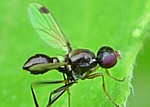
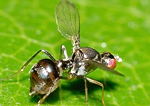
- Family Lauxaniidae - Lauxaniid Flies
- The Lauxaniid Flies has two pair of fronto-orbital bristles. They are usually small to medium size, with clean or marked wings. They like to rest in shaded forest or vegetation. Their larvae are usually found on fallen leaves or other rotting plant materials.
-
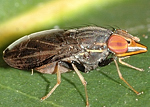
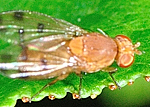
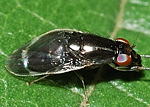
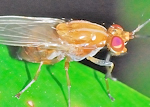
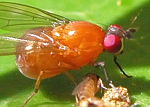
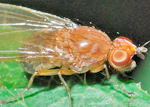
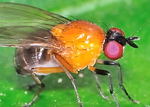

Superfamily Nerioidea
- Family Micropezidae - Stilt-legged Flies
- Flies in this family have very long legs, although the front pair is obviously shorter. Their body is elongated with patterned wings. Most are medium in size. They wave their fore legs in front of head when resting on plants.
-
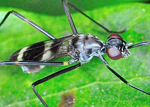
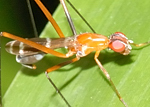
Superfamily Opomyzoidea
- Family Agromyzidae - Leaf Miner Fly
-
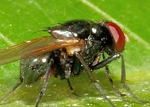
- Family Milichiidae and Chloropidae - Freeloader Flies
- Milichiidae and Chloropidae are two very close related Diptera families. Some species in family Milichiidae and Chloropidae can be found gathering around feeding spider or some other predator insects in order to feed on their prey.
-
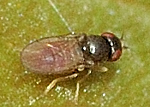
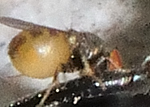
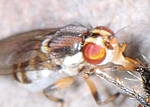
Superfamily Asteioidea
Superfamily Tephritoidea
- Family Platystomatidae - Signal Flies
- Most flies in this family feed on mammalian faeces. Their larvae habits
are varied. Some lives in plant trunk damaged by other insects or fungi. This
group of flies contains the spectacular species, the stalk-eyed signal flies.
The males have eyes on long stalks extending from either side of their
heads.
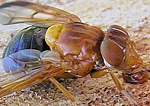
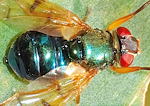
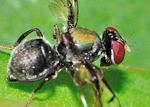
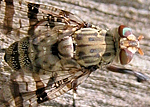
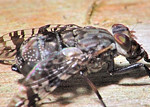
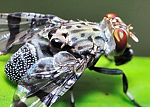
- Family Pyrgotidae - Scarab Flies
- This fly looks similar to those in family PLATYSTOMATIDAE and TEPHRITIDAE. We determined it is in the family PYRGOTIDAE by its wing veins patterns (Sc vein reaching the wing margin at a sharp right angle) and its absent of incurved lower fronto-orbital bristles.
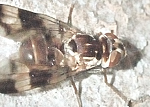
- Family Tephritidae - Fruit Flies
- Most larvae in this family are fruit feeders and some are serious economic pests. The female Fruit flies insert their eggs inside fruit and the larvae live inside.
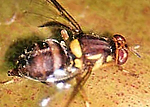
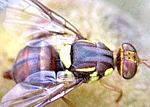

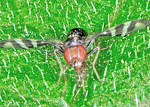
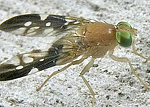
Superfamily Ephydroidea
- Family Ephydridae - Water-skating Flies
- Most species in this family are associated with plants or algae near water.
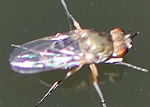
- Family Drosophilidae - Vinegar Flies
- Vinegar Flies are small in size. They usually have red-eyes and yellowish body colour. They often attracted to fermenting or rotting fruit. The larvae are tiny maggots that develop quickly in rotting fruit.
- Unknown Acalyptrata
- Please advise if you recognize any of them. Thank you.
- Reference:
- 1. Insects of Australia, CSIRO, Division of Entomology, Melbourne University Press, 2nd Edition 1991, p717.
- 2. Insects of Australia and New Zealand - R. J. Tillyard, Angus & Robertson, Ltd, Sydney, 1926, p333.
- 3. Catalog of the Diptera of the Australasian and Oceanian Regions - edited by Neal L. Evenhuis, Bishop Museum 2007.
- 4. Diptera (flies) - of Orange County, California, by Peter J. Bryant and Ron Hemberger, University of California
- 5. Northern Territory Insects, A Comprehensive Guide CD - Graham Brown, 2009.
- 6. On the Fly, The Interactive Atlas and Key to Australian Fly Families CD Rom - Hamilton, J. et al. 2006. Brisbane : CBIT & ABRS.
[ Sepsidae ] [ Lauxaniidae ] [ Micropezidae ] [ Agriomyzidae ] [ Milichiidae & Chloropidae ] [ Platystomatidae ] [ Pyrgotidae ] [ Tephritidae ] [ Ephydridae ] [ Drosophilidae ] [ Unknown Acalyptrata Flies ]
